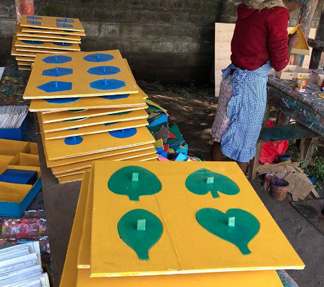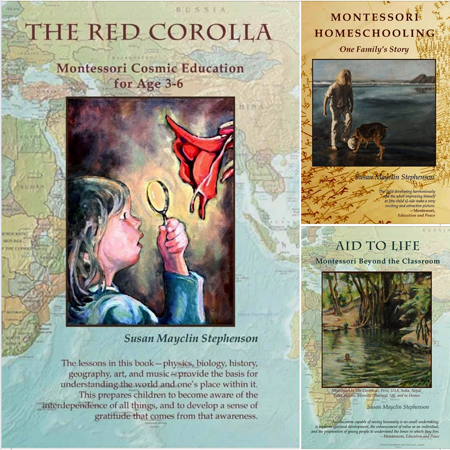|
|
Montessori Books, Materials, and the Preparation of the Environment
|
|
QUICK SEARCH:
|
Montessori observed that children were intensely attracted to certain materials and activities. They used these materials, or engaged in these activities, spontaneously and with deep concentration. Such materials include many of the "tools" that a child sees used by others in the home, for cleaning, cooking, other real work. Children, and adults, emerge from such self-chosen, spontaneous, activity renewed and with a profound sense of inner satisfaction and kindness toward others. This is the essence of a Montessori practice at any age. The Montessori learning environment is much different than the traditional model. Instead of information passing from the teacher to the student, the teacher is skilled in putting the child in touch with the environment, and helping him learn to make intelligent choices and to carry out research in a prepared environment. The teacher then protects the student's concentration from interruption. It is the role of the adult to prepare, and continue to prepare, the environment, to link the child to it through well-thought-out introductions to books and materials, projects, and lessons, which nurture the child's exploration and creativity. Children thus taught often surpass both the level of education of their peers, and the knowledge of the adult — they learn to find answers for themselves.
FIRST MONTESSORI BOOKS - FOR PARENTS AND TEACHERS If Dr. Montessori, and those following her with vast practice a deep understanding, had thought it of value to put Montessori training in a book, it would have been done long ago. It takes 9 years post-university to qualify to be an AMI teacher trainer, and to know when and how to help children take their next step. Parents and teachers who attempt to set up a Montessori environment and give lessons, without proper training, experience frustration. And so do the children. These books—for both parents and teachers—in no way attempt to replace Montessori training. They give the reader many ways to think about the essence of Montessori philosophy and practice, to observe human beings, to understand them, and to aid their development. They are written by a Montessori parent, teacher, and consultant, with many years of experience with children from birth to age 12, and young adults from age 12-18, who is also an oral examiner for teacher training courses. EDUCATIONAL ENVIRONMENTS, MONTESSORI MATERIALS, BOOKS Just as anyone can use the word "Montessori" to describe schools and training centers, they can and do use the name to describe toys and materials that often have nothing to do with Montessori. Quite often suppliers start out with a small selection of good things and then add more and more, veering away from the kind of quality that one would find in a Montessori school. For example, a Montessori teacher avoids plastic, choosing instead natural materials. Also there are no "kits" or "sets" but rather a good supply of beautiful and real materials that the child uses to carry out real work. And although in the first school in Rome there were dolls and imaginative toys, it was discovered early on that, given the choice, children always prefer to learn about and to study and interact with the real world in all its glory. APPROVED MONTESSORI MATERIALS The Association Montessori Internationale (AMI) has always worked to see that materials suppliers meet the qualifications of the best in Montessori Materials. Here is the page with information where official Montessori materials can be found: Nienhuis (worldside) APPROVED TRANSLATIONS OF BOOKS BY MONTESSORI: The Montessori-Pierson Publishing Company publishes and distributes books by Dr. Montessori, in English and other languages. BOOKS FREE DOWNLOADS: to provide support during the Covid-19 pandemic these materials are presently available free from The Association Montessori Internationale. Here also is information on authentic Montessori teacher training centers and other events: AMI MATERIALS A sparse environment of carefully chosen materials calls the child to work, concentration, and joy. A crowded or chaotic environment can cause stress and can dissipate a child's energy. As Montessori education becomes more popular more materials are produced which are labeled "Montessori" and one must be more and more careful in selection. Too many materials, or inappropriate materials can be worse than too few. Birth to Age Six: Before the age of six,
a child learns from direct contact with the environment, by means
of all the senses, and through movement; the child literally absorbs
what is in the environment. The toys and materials in the home and
school for this period of development should be of the very best quality
to call forth self-respect, respect and care from the child toward
the environment, and the development of an appreciation of beauty. Age Twelve +: From age twelve to eighteen, the child's education becomes more traditional: books, computers, and the tools of the place where he may be apprenticing or doing social work. This is transition to adult life during which time the child learns to function in the real world. The environment now includes the farm, the public library, the work place, the large community. At all ages, since the adult's special interests usually lie in one or two areas of study, we must be sure to introduce him to materials and lessons in all areas, all kinds of experiences, and not limit him to our own interests. In the words of the famous music educator Dr. Shinichi Suzuki, "What does not exist in the cultural environment will not develop in the child." MONTESSORI AT HOME & HOMESCHOOLING ENVIRONMENTS Many families are using Montessori principles at homes to provide to provide supportive environments for infants, to supplement the Montessori or other schooling of their children, to make their school studies more vibrant, to teach independence, or sometimes even to completely homeschool their children. Often these parents mistakenly think that they need expensive materials which have been produced for many years for Montessori schools. These materials are made to withstand the constant use of many children over many years and their cost reflects this durability. It is quite possible to provide a Montessori environment without these materials. Montessori Homeschooling page on this site: homeschooling THE ROLE OF TELEVISION, IPADS, PHONES Of course these are valuable tools for education for older children and adults, but we must keep them in balance with other experiences. In support of this balance, here is a quote from the July 1997 issue of The Atlantic Monthly: "Sesame Street" . . . has been around for twenty years. Indeed, its idea of making learning relevant to all was as widely promoted in the seventies as the Internet is today. So where's that demographic wave of creative and brilliant students now entering college? Did kids really need to learn how to watch television? Did we inflate their expectations that learning would always be colorful and fun? . . . . and finally I see a parallel between the goals of "Sesame Street" and those of children's computing. Both are pervasive, expensive and encourage children to sit still. Both display animated cartoons, gaudy numbers and weird, random noises . . . both give the sensation that by merely watching a screen, you can acquire information without work and without discipline. Television . . .Is an anti-experience
and an anti-knowledge machine because it separates individuals from
themselves and from the environment and makes them believe they are
living while they are only observing passively what other people decide
to make them see. The primary danger of the television
screen lies not so much in the behavior it produces as the behavior
it prevents... Turning on the television set can turn off the process
that transforms children into adults. Copyright 2021 This page was updated on April 4, 2021 Webmaster website: Homepage |

